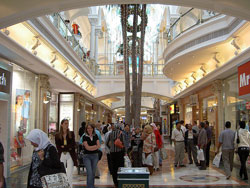
Top stories



Marketing & MediaStranger Things extends record run as all 5 seasons dominate Netflix Top 10
29 Dec 2025


In the past couple of decades, retailers have used the internet to launch the free market to new heights and have nearly swallowed up the traditional physical store model in the process. According to the US Census Bureau, e-commerce sales in the USA have increased around 300% in the last 10 years. There are no ups and downs in these numbers, that's 18 consecutive quarters of positive growth. As people continue to choose online shopping over in-store purchases, what does that mean for the future of e-commerce and what are retail stores doing to keep people coming in?
This year, the total number of mobile phones is expected to exceed the number of humans alive to use them. It seems like people are spending more time socialising via these little devices than they do in person. Smart phones have changed the landscape of the mobile phone world and it is having a dramatic effect on e-commerce.
More and more businesses are optimising their online shopping experience for mobile devices. Mobile e-commerce sales hit $4.7bn last year, and people are taking notice.
Some retail stores have started to implement mobile based POS systems in store in an effort to bring the convenience of shopping online to the physical store experience.
Surveys show that 71% of social media users are more likely to purchase from a brand they follow online. Every business knows the importance of establishing a solid online presence and the current necessity to use social media to do so. However, it goes much deeper than simple putting your brand where the eyes are. In the physical world, people cannot simply enter a store by looking at your billboard or bus stop ad.

In the online world, advertisements are clickable and directly linked to your online store. There is nothing faster and nothing simpler than the e-commerce shopping experience, and it seems likely that this is a large part of its success. People want to save themselves time and effort when it comes down to it, and the interconnected nature of e-commerce gives them exactly that.
Retail stores have conceded to a point that e-commerce is here to stay and have accepted it as an integral part of their future. The use of in-store QR codes and in-store pickup are just a couple of the ways that physical retailers are creating a hybrid experience with the benefit being the immediacy of buying in person.
Aside from the sheer number of sales over the last decade, the amount the people are spending has also gone up and looks to continue to go up. In 2013, e-commerce sales amounted to about $1.5trn (trillion), while in 2017 that number is expected to more than double to $3.2trn. If the current retail sales numbers stayed even, that would likely account for 12-15% of total sales, domestically.
The market size for physical retails is quite visibly shrinking, and they're going to have to continue to be creative in the ways they keep people coming into their stores. It's difficult for them to compete with prices and selection, so they will have to focus their efforts where they have the upper hand: immediacy and customer service.
In conclusion, we can expect new trends to emerge as e-commerce continues to grow and is forced to compete more directly with itself and less with physical retailers. We can certainly expect some exciting things from the consumer perspective in the coming years.
